February 2020 Newsletter

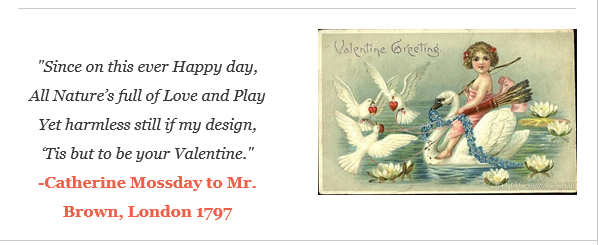
Won’t You Be My Valentine?
The origins of Valentine’s Day date back to ancient Rome and the fertility feast of Lupercalia. From February 13th through 15th, Roman men sacrificed goats and used their skins to whip women under the assumption that this would make them fertile (sounds like a party I wouldn’t want to attend!). At the end of the 5th century, Pope Gelasius I ‘Christianized’ the pagan festival, declaring February 14 as Valentine’s Day in honor of one or both Saints named Valentine: Valentine of Terni (197AD) and Valentine of Rome (496AD). In 1382, Geoffrey Chaucer wrote Parlement of Foules:
“For this was on seynt Volantynys day
Whan euery foul comyth there to chese his make.”
It is uncertain if Chaucer was referring to February 14th or to the feast of St Valentine of Genoa, which falls in May. In the fifteenth century, the French celebrated on February 14th with a romantic feast of love. Lavish banquets with singing and dancing were held to mark the occasion. It was also a 15th-century Frenchman who committed the earliest surviving Valentine’s greeting to paper. While imprisoned in the Tower of London following the 1415 battle of Agincourt, the Duke of Orleans wrote to his wife:
“Je suis desja d’amour tanné
Ma tres doulce Valentinée”
(I am already sick of love,
my very gentle Valentine)
And let’s not forget one of my all-time favorites, Shakespeare’s Hamlet, when Ophelia says:
To-morrow is Saint Valentine’s day
All in the morning betime,
And I a maid at your window,
To be your Valentine.
(And by the way, I played Ophelia a long time ago when I was a teenager and into theater.)
The 18th century was the beginning of Valentine’s Day greetings as we know them today. They were handmade sentiments that lovers would decorate with romantic symbols including flowers and love knots, often including puzzles and lines of poetry. The paper cards were slipped secretly under a door, or tied to a door-knocker. An interesting trend in the late 1700s included acrostical Valentines. Early Virginians turned the pages of the Virginia Gazette into a clever secret message board!


Industrialization in the early nineteenth century brought with it mass-produced Valentine’s cards. By the mid-1820s, some 200,000 Valentines were circulated in London alone. How many were circulated in America is unclear. Many Victorian Valentine’s cards survive with some featuring elaborate paper lacework, embossing and other intricate designs. Interestingly, these cards did not feature the ubiquitous red hearts that are so typical of Valentine’s cards today. Instead, imagery included flowers, love knots, birds and Cupid. Take a look at some of my vintage favorites here.


Extra Extra Read All About It!
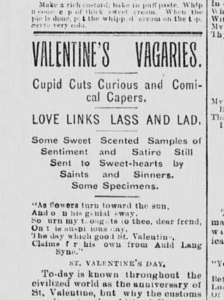
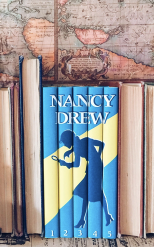
Happy Birthday Nancy Drew!
If you were a kid any time over the last 90 years, chances are that you had Nancy Drew (and her friends The Hardy Boys) on your book shelf.
When I was a kid, however, my parents couldn’t afford Nancy Drew’s books, BUT, the grocery store sold a different Trixie Belden mystery each week for $1. Sixteen weeks later, I had all sixteen books!
So in celebration of Nancy, and because I’d like to read them now, I’d like to give away a collection of her best stories. Keep your eye on my IG and Facebook pages, for a chance to enter and win!
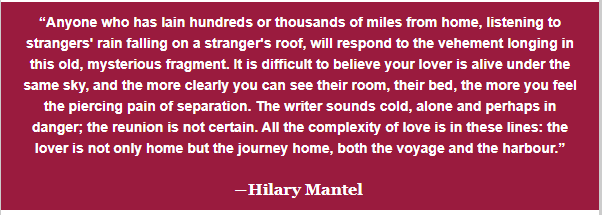
For the Love of Chocolate
(GLUTEN AND LACTOSE FREE!)
Want a decadent treat that is gluten and lactose friendly? Here’s an easy recipe you might want to keep in your recipe file for something that’s both decadent and respectful of your loved ones with delicate stomachs. Follow the recipe here:

Inside Selma’s Walls:
Valentine’s Day at Selma
Last year on Valentine’s Day, Scott and I invited a few of our favorite couples for a candlelight dinner and conversation. We served strawberries over brie with champagne to start, poached salmon with rosé for dinner and a bit of chocolate with a glass of nice port to finish the evening. Just an intimate gathering of friends to celebrate in the quiet of the place we call home.
Awash in color, beautiful pinks and reds and sumptuous textures, Selma is all decked out for Valentine’s Day. For more photos inside the mansion on this special day take a look here.
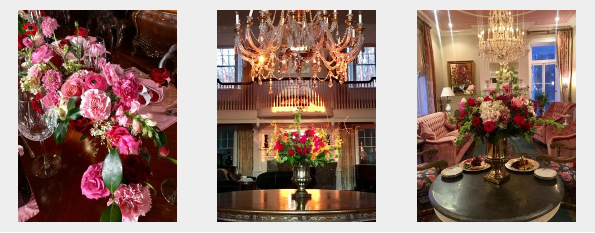
Don’t forget to check my Instagram page for details on our February Book Club selection.








